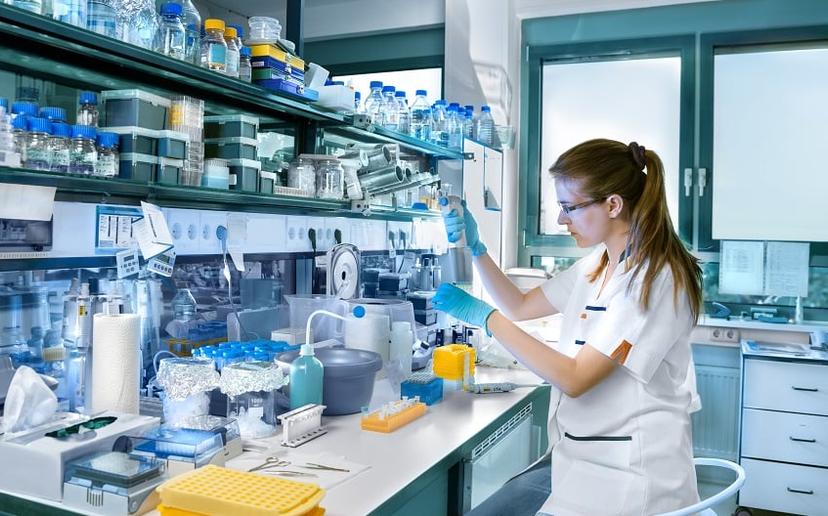Webinar Highlights - Laboratory Safety - Safe Storage of Chemicals
Highlights from the Q&A session of this essential webinar
13 Sept 2016

Image: Biological Lab, Anyaivanova/Shutterstock

Herbert Heidfeldt, Consultant for Environment, Health & Security at Darmstadt, Germany
The safe storage of chemicals in the laboratory is vital to ensure the health and safety of employees, as well as being required by Occupational Health and Safety (OHS) guidelines. Do you know how best to store the chemicals to meet all safety requirements and legislation?
In this webinar, Herbert Heidfeldt, Consultant for Environment, Health & Security at Darmstadt, Germany, gives a basic safety lecture on the safe storage of chemicals and discusses the daily challenges lab employees may face to manage their work in compliance with OHS requirements. Read on for the highlights of the Q&A session with Herbert. If you missed it, watch the full webinar here.
Q: Is it really necessary to separate chemicals strictly according to the storage regulations?
A: Yes, combinations of chemicals may cause uncontrollable explosions or reactions. The damages, costs and potential penalties that could result can create big difficulties for the accountable employees. Therefore, I think it is very important to separate chemicals and follow the regulations.
Q: What is a safe length of time to store an open four-liter bottle of tetrahydrofuran in a flammable storage cabinet?
A: There is not any information about for the safe time that material can be stored. Suitable containers and storage cabinets should be used for safe chemical handling. Normally, chemical containers should be closed, labelled and stored in a cabinet and only taken out for use. Whether using tetrahydrofuran, or another chemical, follow the information on the safety data sheet. No safe time scale can be given for storage of an open bottle. I suggest that you read the safety data sheet and follow its advice and if you have any queries talk with a safety officer, as it is potentially dangerous.
Q: Is it safe to store powdered chemicals on shelves that are above eye level?
A: It is not recommended not to store any chemicals above eye level due to the risk of possible eye contact. Many people in laboratories do not wear safety glasses but even when wearing them you are not completely protected, regardless of whether they are powdered or liquid. I would recommend that chemicals are not stored above eye level. However, if you do have to store chemicals above eye level, then put them in a plastic box for extra protection.
Q: What is the best way to transfer acetone from a twenty-liter container to a two-liter glass bottle?
A: It would be best to use an explosive protected room with a safe system. This safe system would consist of closed pumping equipment, which is connected to the steel twenty-liter container and grounded equipment for filling the two-liter glass bottle. Safe systems such as these are offered by Merck and other companies. It is important that you use an explosive protected room, an exhaust system and the correct personal protective equipment.
Q: I have small quantities of acid solutions and a lot of non-flammable chemicals in powdered form. Can I store the dried chemicals in a lower position in the same cabinet with the salts?
A: It is possible but some oxy-materials cannot be stored with others. For example, when some oxy-powders come together with lipids, they are very explosive. You have to check the chemicals according to the storage class but generally you can store dry chemicals and solutions together. Remember to store liquids in the lower shelves and install ground basins to avoid difficulties with leakages.
Q: We use flammable solvents in plastic bottles for daily work, how do we store these? Should we store them overnight in a safety cabinet or can we leave them on our work benches?
A:This is a good question. Normally you should have a risk assessment for every laboratory process. If you decide that the bottles are small enough to be stored in the room overnight, check the risk assessment to find out what the maximum allowable volume is for the solvents in your laboratory. This is based on other risk factors, for example the room size or the type of work carried out in the laboratory.
Q: What is the most reliable source for safety data sheets?
A: Companies such as Merck KGaA will provide valid copies of data sheets free of charge. These can be found by searching for the material name or item number online. If you need more than one safety data sheet, store them in a clearly dedicated folder in the laboratory, and you should have a person in the laboratory responsible for organization of the folder.
Q: We only have the older safety labels on chemical containers, do we have to upgrade these to the new Global Harmonized System of Classification and Labeling of Chemicals (GHS) signs?
A: These need to be updated. Check your local regulations as it is required by GHS to have the correct labels on all containers.
Q: How long is the information on a safety data sheet valid?
A: This is a difficult question to answer, some materials such as sodium hydroxide can be stored for a very long time without any changes. However, in general you should review the content of the safety data sheet yearly. Remember to take other laboratory factors into consideration, for example temperature or humidity.
Q: What should I do if I find a container that is corroded and does not have any labels?
A: This situation requires a written process of what to do with unidentifiable materials. You need a designated person in your company, for example a safety officer, who can deal with this. Depending on the size of the unidentified container, you should first separate it into special refuse bottles or containers and discuss disposal methods with the appropriate person. Check the local legislation.
Q: Is it necessary to have risk assessments for storage in the laboratory?
A: Risk assessments are needed for anything that can impact safety and, in most parts of the world, are also required by law. This extends to the storage of chemicals. You need to have a risk assessment before you store anything in a laboratory.
Find out more about laboratory safety tools and products and download Merck StoreCard information.
